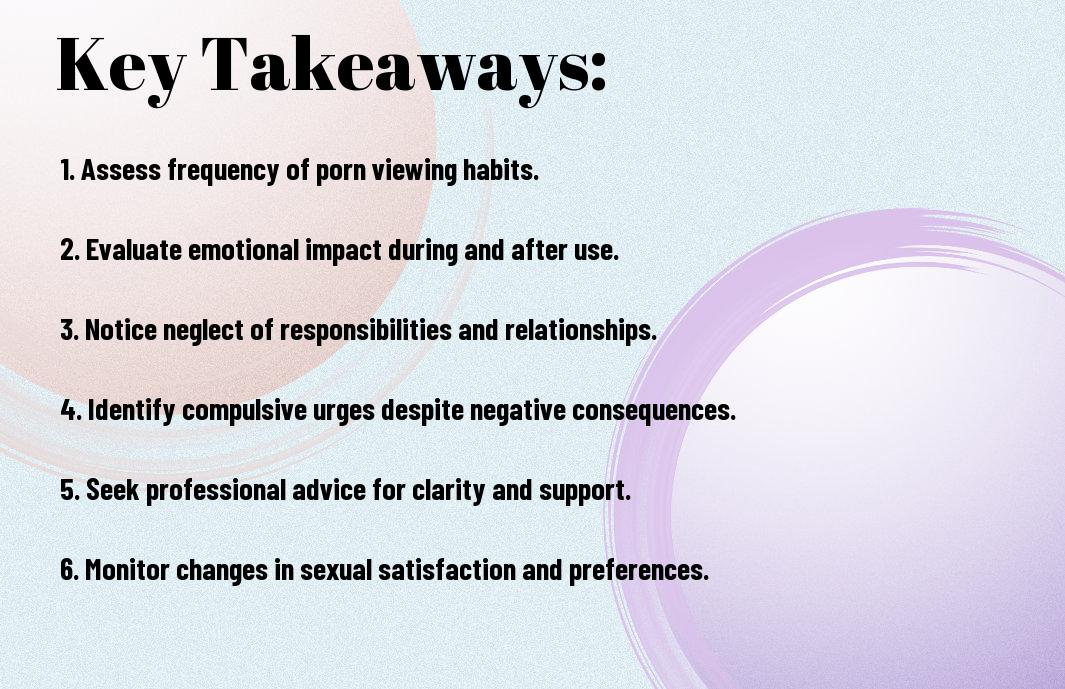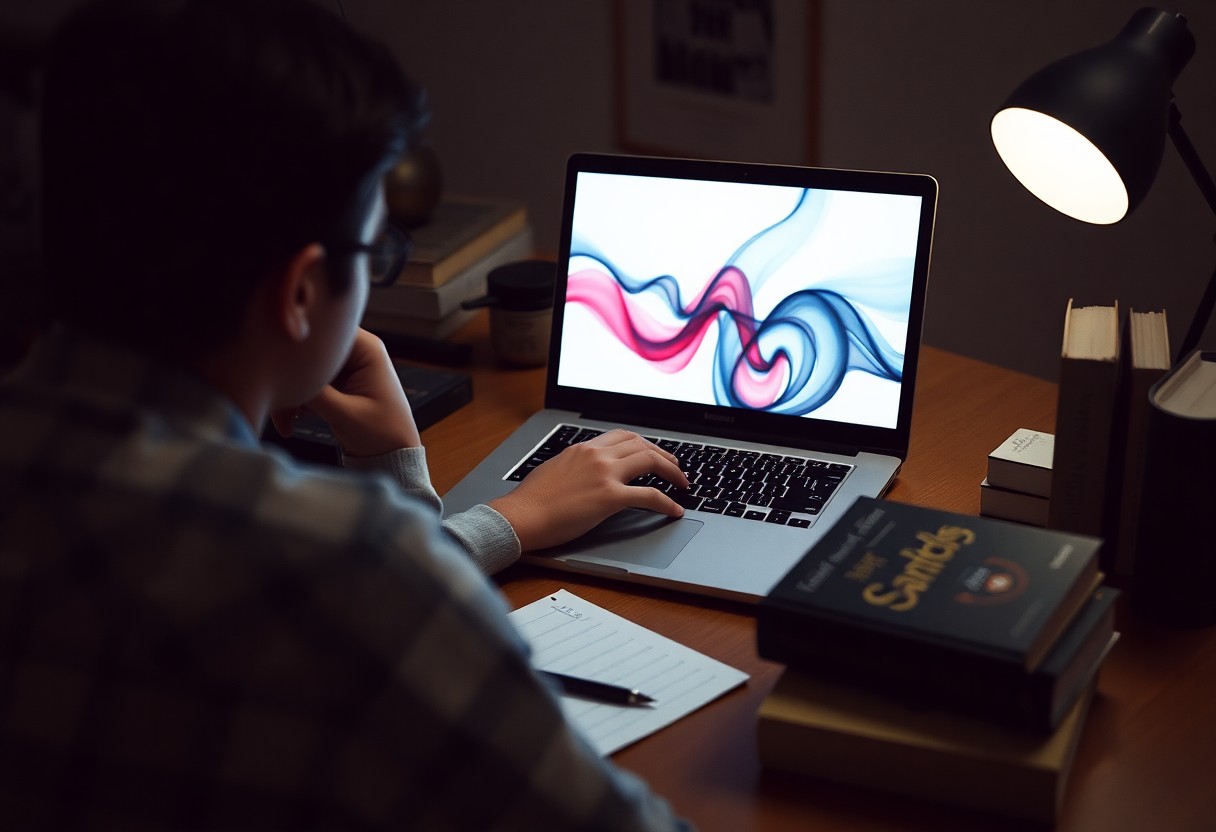With the increasing accessibility of adult content online, recognizing the signs of a potential porn addiction has become more important than ever. You may find yourself uncertain about whether your viewing habits are healthy or problematic. This post offers 13 expert-approved tips to help you assess your relationship with pornography and determine if you need to make some changes in 2025 and beyond. Understanding your behavior is the first step towards achieving a healthier lifestyle and improved well-being.
Key Takeaways:
- Evaluate your consumption patterns: Assess how often and why you engage with pornography to identify potential addictive tendencies.
- Consider emotional triggers: Reflect on whether you use pornography as a coping mechanism for stress, boredom, or emotional discomfort.
- Notice impact on relationships: Observe if your porn usage affects your intimacy or connection with partners or friends.
- Assess time spent: Track the amount of time dedicated to watching porn and whether it interferes with daily responsibilities.
- Check for compulsive behavior: Identify if you have difficulty reducing or stopping your consumption despite wanting to.
- Recognize withdrawal symptoms: Be aware of any anxiety, irritability, or depression when trying to cut back on porn use.
- Seek professional insight: Consult a therapist or counselor if you identify signs of addiction for guidance and support.


Understanding Porn Addiction
As you examine into the complexities of porn addiction, it’s important to recognize its impact on your life. This form of addiction can profoundly affect your relationships, emotional health, and overall well-being, often resulting in a compulsive pattern of behavior. Understanding its nuances will empower you to identify whether you’re struggling with this issue and seek the support you need.
Definition of Porn Addiction
For many people, porn addiction manifests as a compulsive need to consume pornography despite negative consequences. This persistent engagement can lead to deteriorating relationships, emotional distress, and even interference with daily life, characterizing a dependency on porn for pleasure and escapism.
Signs and Symptoms
Symptoms of porn addiction can be subtle but impactful, making them imperative to identify. They often include preoccupation with porn, escalating demands for more intense material, and neglecting personal or professional responsibilities in favor of viewing habits. If you find yourself feeling guilt or shame about your consumption yet continue to engage, it may indicate a deeper issue.
Addiction to pornography can create an array of signs and symptoms that disrupt your life. You might experience increasing tolerance, requiring more explicit content to achieve the same satisfaction. Additionally, withdrawal symptoms can arise when you attempt to cut back, including irritability or anxiety. This cycle of behavior can lead to feelings of isolation, difficulties in real-life relationships, and reliance on pornography as a primary source of arousal, which ultimately highlights the need for self-reflection and potential intervention.

Evaluating Your Behavior
Clearly, assessing your behavior is an necessary step in understanding your relationship with porn. By taking a closer look at your habits and patterns, you can determine whether what you’re experiencing goes beyond casual use. Observing the frequency and triggers behind your consumption can provide valuable insights into your potential addiction.
Frequency and Duration
Any excessive engagement with pornographic material, particularly if it has become a daily ritual, may signal a problem. If you find yourself watching porn multiple times a day or spending hours in front of your screen, it’s necessary to reflect on why this is happening and what need it fulfills.
Impact on Daily Life
Beside the frequency of your use, consider how it affects your day-to-day responsibilities and relationships. If you find your productivity slipping, social interactions diminishing, or personal goals being sidelined due to excessive porn consumption, it might be a sign of a deeper issue.
Due to the addictive nature of porn, its impact can permeate various aspects of your life—leading to neglect in work, strained relationships, and even behavioral changes. You may notice an increased sense of guilt or shame following your use, which can further compound your stress and anxiety. Evaluating how your habits affect your overall quality of life is vital in determining whether you need to seek help or make significant changes.
Psychological and Emotional Effects
For many individuals, the impact of porn addiction extends beyond mere habits, often leading to profound psychological and emotional effects. You may find yourself grappling with feelings of shame, guilt, or worthlessness, which can progressively escalate. These feelings can interconnectedly affect various aspects of your life, from stress management to overall mental well-being. Recognizing these signs is crucial for understanding the scope of your situation and seeking necessary support.
Anxiety and Depression
Depression can manifest alongside anxiety in individuals struggling with porn addiction. You might find that your mood fluctuates significantly, often feeling overwhelmed by sadness and hopelessness. The cycles of viewing and compulsively seeking pornography can exacerbate feelings of isolation and contribute to heightened anxiety levels, affecting your daily functioning and overall peace of mind.
Relationship Issues
Depression linked to porn addiction can significantly affect your interpersonal relationships. You may experience difficulties in communication and intimacy with your partner, fostering a sense of distance and disconnection. These struggles can lead to mistrust and resentment, complicating your ability to engage in healthy, fulfilling relationships. As you navigate these challenges, it’s vital to address underlying issues to foster improved connections.
Psychological distress stemming from porn addiction often translates into increased relationship issues. You may notice patterns of avoidance or withdrawal when it comes to intimacy, creating barriers between you and your loved ones. This disconnect can erode trust and diminish the quality of your relationships, leading you to feel emotionally isolated. Openly addressing these issues, perhaps through therapy or support groups, can help you rebuild connections and restore emotional intimacy.
Expert-Approved Self-Assessment
All experts agree that a self-assessment can help you determine if you may have a porn addiction. By taking a step back and evaluating your behaviors and feelings, you can gain deeper insight into your habits. Consider the patterns of your consumption, the impact on your life, and any feelings of guilt or shame that arise when engaging with pornographic content.
Questions to Consider
Consider your relationship with porn by reflecting on these questions: How often do you watch porn? Does it interfere with your daily life or responsibilities? Do you find yourself using it to cope with stress or emotions? Are your viewing habits escalating? Answering these questions can help you better understand your relationship with pornography.
Seeking Professional Help
ExpertApproved guidance suggests that seeking professional help can be a beneficial step if you suspect a porn addiction. A mental health professional can provide you with the tools and strategies needed to address your compulsive behaviors and underlying issues.
With ongoing support from a therapist, you can explore your feelings toward pornography, identify triggers, and develop healthier coping mechanisms. Therapy can also help you address any emotional connections to your porn use, fostering a better understanding of your needs and establishing healthier habits in your daily life.

Strategies for Overcoming Porn Addiction
After recognizing the signs of porn addiction, it’s imperative to implement effective strategies for recovery. Overcoming Porn Addiction: Steps to Begin Healing can guide you toward healthier habits and a more balanced lifestyle.
Setting Boundaries
Beside understanding your triggers, it’s important to establish clear boundaries regarding your internet usage. This can include limiting access to devices during certain times of the day or using filters to block explicit content. By defining these limits, you create a healthier environment that encourages your recovery.
Alternative Activities
Along your journey to recovery, engaging in alternative activities can help distract you from urges while improving your overall well-being. Consider exploring hobbies such as reading, exercising, or joining a community group that aligns with your interests.
Considering alternative activities not only provides an outlet for your energy but also fosters connections with others who share your interests. Diving into creative or physical engagements can enhance your mood and reduce the cravings you may experience. Find what excites you; whether it’s painting, hiking, or learning a new skill, these pursuits can redirect your focus and motivate you away from pornographic content.
Building a Support System
Keep in mind that developing a strong support system is imperative for overcoming porn addiction. Surrounding yourself with understanding individuals can provide the encouragement necessary to make lasting changes. To gain insight into the prevalence and effects of porn addiction, consider reviewing Porn Addiction Statistics – Rates, Demographics & Effects … which highlights its widespread impact.
Support Groups
Groups focused on recovery can be highly beneficial in your journey. They provide a safe space where you can share experiences, gain insights from others, and access valuable resources to help you navigate your struggles with porn addiction.
Talking to Family and Friends
Against common fears, opening up to loved ones about your addiction can lead to unexpected support. Sharing your journey with trusted family members or close friends allows for a deeper understanding and creates an opportunity for accountability. When those you care about know your challenges, you’ll likely find solidarity and encouragement as you work toward recovery.
Indeed, having open conversations with family and friends can significantly ease the burden of your experience. By expressing your feelings and challenges, not only are you fostering understanding, but you’re also creating an environment where you can lean on others during tough moments. Many people have found that disclosing their struggles helps diminish feelings of isolation, paving the way for healing and stronger relationships.
Summing up
Ultimately, recognizing whether you have a porn addiction involves a combination of self-reflection and awareness of your behaviors and feelings. By following the 13 expert-approved tips outlined, you can evaluate your relationship with pornography and assess its impact on your life. Be open to seeking support if you identify problematic patterns, and understand that seeking help is a positive step toward enhancing your well-being and relationships. Your journey towards a healthier balance with digital content starts with honest self-assessment and proactive measures.
FAQ
Q: What are the signs of porn addiction?
A: Some common signs include spending excessive time viewing pornography, neglecting responsibilities and relationships, feeling unable to stop despite wanting to, using porn as a coping mechanism for stress or anxiety, and experiencing negative emotions like guilt or shame related to porn use.
Q: How can I determine if my porn use is problematic?
A: Assess your porn consumption patterns. If you find that your use interferes with daily activities, leads to relationship issues, or causes emotional distress, it may be a sign of a more serious problem. Keeping a journal to track your habits and feelings can provide clarity.
Q: Are there specific criteria that classify porn addiction?
A: Yes, experts suggest looking for behaviors similar to other addictions. This includes loss of control over your behavior, withdrawal symptoms when not using porn, and continued use despite harmful consequences to your personal or professional life.
Q: How effective are self-assessment tools for identifying porn addiction?
A: Self-assessment tools can be a helpful starting point. They often include questions about consumption frequency, emotional responses to porn use, and its impact on your life. However, consulting with a mental health professional can provide a more thorough evaluation.
Q: Can porn addiction affect my relationships?
A: Yes, porn addiction can lead to unrealistic expectations about intimacy, decreased sexual satisfaction with partners, and emotional disconnection. Openness and communication with your partner about any struggles can help foster understanding and support.
Q: What steps can I take if I think I have a porn addiction?
A: Begin by acknowledging your concerns and seeking support. Consider speaking with a therapist who specializes in addiction, joining support groups, and setting limits on your porn consumption. Engaging in alternative activities and finding healthier coping mechanisms can also be beneficial.
Q: Is it possible to recover from a porn addiction?
A: Absolutely! Recovery is a gradual process and can involve therapeutic intervention, support groups, and personal commitment to change. Many individuals successfully reduce their dependency on porn and establish a healthier relationship with sexuality.
